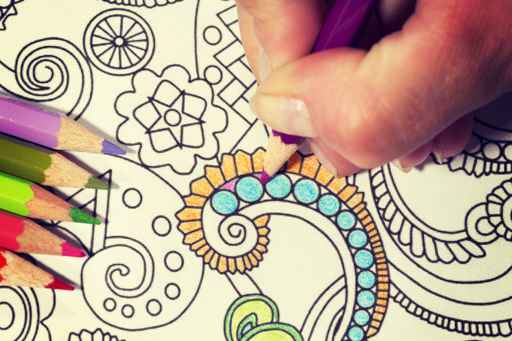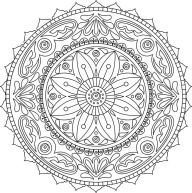 When you think of coloring what comes to mind? A box of fresh Crayola 64 Crayons? White paper? The smell? The vibrant colors with the neat paper labels? Did you have a favorite coloring book? What’s your favorite color?
When you think of coloring what comes to mind? A box of fresh Crayola 64 Crayons? White paper? The smell? The vibrant colors with the neat paper labels? Did you have a favorite coloring book? What’s your favorite color?
Today, if you walk into any bookstore you will see tables filled with adult coloring books. Coloring is not just for children anymore. While these coloring books should not be confused with “Art Therapy” (which is a therapeutic modality practiced by a licensed professional), coloring itself can be beneficial. The benefits of coloring for adults are being discussed far and wide.
As early as the 1920s, one of the fathers of psychology, Carl Jung, found that coloring mandalas had a calming effect on his adult patients and helped them access their subconscious. More recently, Dr. Stan Rodski, a neuro-psychologist who also happens to be the author of his own line of adult coloring books, says that coloring elicits a relaxing mindset, similar to what you would achieve through meditation. Like mediation, coloring allows us to switch off our brains from other thoughts and focus on the moment. Tasks with predictable results, such as coloring or knitting, can often be calming — Rodski was even able to see the physical effects they had on our bodies by using advanced technology. “The most amazing things occurred — we started seeing changes in heart rate, changes in brainwaves,” he told the Australian Broadcasting Corporation, adding that part of this neurological response in “colorists” comes from the repetition and attention to patterns and detail associated with coloring.

According to psychologist Gloria Martínez Ayala, coloring activates both hemispheres of the brain. “The action involves both logic, by which we color forms, and creativity, when mixing and matching colors. This incorporates the areas of the cerebral cortex involved in vision and fine motor skills [coordination necessary to make small, precise movements]. The relaxation that it provides lowers the activity of the amygdala, a basic part of our brain involved in controlling emotion that is affected by stress.” In other words, when we focus on coloring we are fully in the present moment and therefore not focused on the future (associated with anxiety) or the past (associated with regret, guilt, depression). Coloring also brings us back to our childhood and associations to simpler, less stressful times.
Deborah Serani, Psy. D. In Psychology Today offers Tips for Coloring:
- Follow your heart.Seek out a coloring book that suits your interests. There are many to choose from – geometric designs, landscapes, animals, characters, story-driven, spiritual and religious, just to name a few. And don’t forget that plain white paper and a great set of colorful tools can be as good as a pre-printed book.
- Consider your eyes. Once you’ve found a theme, choose a book that’s easy on your eyes. For example, older adults prefer less intricately drawn pictures to color.
- Choose variety and richness.If you can, spend a little extra on your coloring tools. Be it crayons, pencils, watercolors, gel pens, markers or pastels, the more color choices and textures, the better your coloring experience.
- Be present.When using coloring as a way to increase well-being, find a way to revel in the solitude of the experience. Reduce distractions and focus your intentions on the colored hues, patterns and strokes you choose.
- Use mindfulness techniques. Studies suggest that using positive expression as you color offers beneficial effects[v]. Try saying things like “I enjoy doing this” or “I like this color blue. It reminds me of my favorite beach.” Recalling meaningful moments or just having a one-word mantra like “Peace” or “Joy” can help you get there.
 There are a variety of apps and websites that offer opportunities for meditative coloring. I like Print Mandala for free mandalas that can be printed from my computer. For people who prefer to “color” using technology, there are a variety of free apps for coloring. One of my favorites is Pigment which allows the user to choose brushes for coloring along with the option to simply “fill” the space. This gives the user the opportunity to experience the actual motion of coloring while using this app rather than simply filling-in the spaces.
There are a variety of apps and websites that offer opportunities for meditative coloring. I like Print Mandala for free mandalas that can be printed from my computer. For people who prefer to “color” using technology, there are a variety of free apps for coloring. One of my favorites is Pigment which allows the user to choose brushes for coloring along with the option to simply “fill” the space. This gives the user the opportunity to experience the actual motion of coloring while using this app rather than simply filling-in the spaces.
 No matter your preference for color, medium or modality, try your hand at coloring in this way and see if it offers you the benefits that so many people are talking about. Give yourself the opportunity to immerse yourself in the repetitive, contained movement as well as the creativity and self-expression and see what you can create.
No matter your preference for color, medium or modality, try your hand at coloring in this way and see if it offers you the benefits that so many people are talking about. Give yourself the opportunity to immerse yourself in the repetitive, contained movement as well as the creativity and self-expression and see what you can create.

I have heard of adult colouring books before, yet I have not seen it written about in such detail until now. I also had no idea that this kind of mindfulness has its roots as far back as the 1920s! You might have actually inspired me to give it a go myself. Thank you for writing this entry 🙂
LikeLike